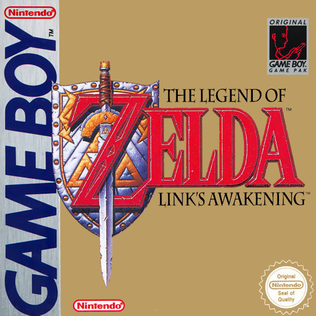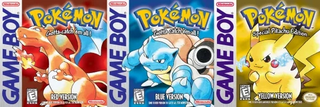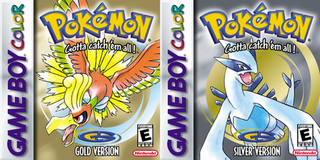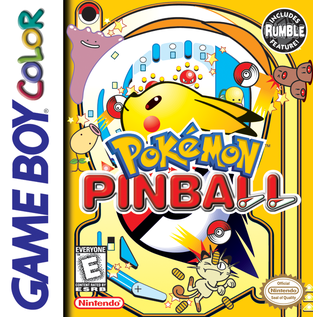
The Game Boy Advance (GBA) is a 32-bit handheld game console developed, manufactured and marketed by Nintendo as the successor to the Game Boy Color. It was released in Japan on March 21, 2001, in North America on June 11, 2001, in the PAL region on June 22, 2001, and in mainland China as iQue Game Boy Advance on June 8, 2004.

Kid Icarus is a platform video game developed and published by Nintendo for the Family Computer Disk System in Japan and the Nintendo Entertainment System in Europe and North America. It was released in Japan in December 1986, in Europe in February 1987, and in North America in July.

Mario Kart: Super Circuit is a 2001 kart racing game for the Game Boy Advance (GBA). It is the third Mario Kart game and retains its predecessors' gameplay: as a Mario franchise character, the player races opponents around tracks based on locales from the Super Mario platform games. Tracks contain obstacles and power-ups that respectively hamper and aid the player's progress. Super Circuit includes various single-player and multiplayer game modes, including a Grand Prix racing mode and a last man standing battle mode.

Super Mario World, known in Japanese marketing as Super Mario World: Super Mario Bros. 4, is a platform game developed by Nintendo EAD and published by Nintendo for the Super Nintendo Entertainment System (SNES). It was released in Japan in 1990, North America in 1991 and Europe and Australia in 1992. The player controls Mario on his quest to save Princess Peach and Dinosaur Land from the series' antagonist Bowser and the Koopalings. The gameplay is similar to that of earlier Super Mario games; players control Mario through a series of levels in which the goal is to reach the goalpost at the end.

River City Ransom, known as Street Gangs in PAL regions, is an open world beat 'em up video game originally for the Nintendo Entertainment System. It is an English localization of Downtown Nekketsu Monogatari for the Famicom. The game was developed by Technōs Japan and released in Japan on April 25, 1989.

The Legend of Zelda: Link's Awakening is a 1993 action-adventure game developed and published by Nintendo for the Game Boy. It is the first installment in The Legend of Zelda series for a handheld game console. Link's Awakening is one of the few Zelda games not to take place in the land of Hyrule, and it does not feature Princess Zelda or the Triforce relic. Instead, the protagonist Link begins the game stranded on Koholint Island, a place guarded by a whale-like deity called the Wind Fish. Assuming the role of Link, the player fights monsters and solves puzzles while searching for eight musical instruments that will awaken the sleeping Wind Fish and allow him to escape from the island.

Pokémon Red Version and Pokémon Blue Version are 1996 role-playing video games developed by Game Freak and published by Nintendo for the Game Boy. They are the first installments of the Pokémon video game series. They were first released in Japan in 1996 as Pocket Monsters Red and Pocket Monsters Green, with the special edition Pocket Monsters Blue being released in Japan later that same year. The games were later released as Pokémon Red and Pokémon Blue in North America and Australia in 1998 and Europe in 1999. Pokémon Red and Pokémon Blue combined Red/Green/Blue for release outside of Japan.

Pokémon Gold Version and Pokémon Silver Version are 1999 role-playing video games developed by Game Freak and published by Nintendo for the Game Boy Color. They are the first installments in the second generation of the Pokémon video game series. They were released in Japan in 1999, Australia and North America in 2000, and Europe in 2001.

Balloon Fight is an action video game developed by Nintendo and HAL Laboratory and published by Nintendo. The original arcade version was released for the Nintendo VS. System internationally as Vs. Balloon Fight, while its Nintendo Entertainment System counterpart was released in Japan in 1985 and internationally in 1986.

Pokémon Pinball is a pinball-based Pokémon spin-off video game for the Game Boy Color. It was released in Japan on April 14, 1999, and in North America on June 29, 1999. In it, the ball is a Poké Ball, and most of the objects on the table are Pokémon-related.
Pikmin is a real-time strategy and puzzle video game series created by Shigeru Miyamoto, and published by Nintendo. The games focus on directing a horde of plant-like creatures called Pikmin to collect items by destroying obstacles, avoiding hazards, and fighting fauna that are hazardous to both the player character and the Pikmin.

F1 Race is a racing video game developed by HAL Laboratory and published by Nintendo for the Famicom in 1984. A version was released in 1990 for the Game Boy in Japan and in 1991 in Europe and North America, including the Four Player Adapter for four-player gameplay.
The Virtual Console is a defunct line of downloadable video games for Nintendo's Wii and Wii U home video game consoles and the Nintendo 3DS family of systems.

Lost in Blue 3 is a survival game developed by Matrix Software and published by Konami for the Nintendo DS handheld video game console. It is the sequel to Lost in Blue 2. It was released on December 20, 2007 in Japan with the North American version released on March 18, 2008.

The Japanese multinational consumer electronics company Nintendo has developed seven home video game consoles and multiple portable consoles for use with external media, as well as dedicated consoles and other hardware for their consoles. As of September 30, 2021, in addition to Nintendo Switch, Nintendo has sold over 863.07 million hardware units.
There have been a variety of Sesame Street video games released for video game platforms. Most of the Sesame Street video games were published and developed by NewKidCo.

Cube Life: Island Survival is an indie open world sandbox survival video game developed and published by Cypronia. It was released for Wii U in June 2015. An HD remake was released for Steam in April 2018, for Android and iOS in August 2018, and for Nintendo Switch in December 2020.

Paper Mario: Color Splash is a 2016 role-playing game developed by Intelligent Systems and published by Nintendo for the Wii U console. It is the fifth installment in the Paper Mario series, within the larger Mario franchise. The story follows Mario and his new ally Huey on a quest to save Prism Island and rescue Princess Peach from Bowser.

Lost in Blue is a series of survival video games published by Konami. They revolve around the main characters being castaways on a desert island and being forced to scavenge for survival. The series saw two Game Boy Color releases starting in 1999, only one of which was localized, before going on a five-year hiatus. It then saw several Nintendo DS installments, adopting a new localized name, Lost in Blue. Following the release of a Wii installment of the series, it went on indefinite hiatus.
















